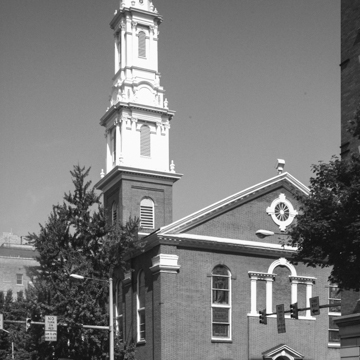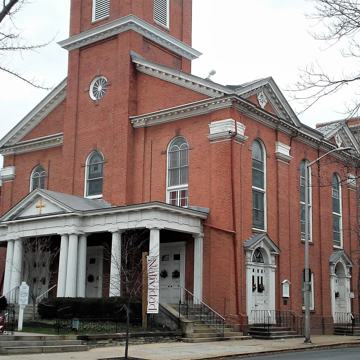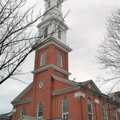Trinity Lutheran belongs to an architectural sequence that includes Philadelphia's St. Peter's Protestant Episcopal Church ( PH18) and Robert Smith's Zion Lutheran Church (1766–1769; 1794 burned and rebuilt; demolished), and a ministerial lineage that includes the son and grandson of the patriarch of American Lutheranism, Henry Melchior Muhlenberg, who founded the nearby church at Trappe ( MO32). The original brick church, with its large Palladian window on the east wall and its modest west tower was augmented in a series of renovations that attest to the congregation's wealth and their desire to continue as the leading congregation of the city. This is evident in the construction in 1833 of the extraordinary 203-foot-high steeple atop the earlier bell tower that for some time was the tallest structure in the state. It was based on the tower of Philadelphia's Second Presbyterian church on Arch Street. The church was modified again in 1851 when the church's original grand space with balconies was raised a story to accommodate first-floor offices and Sunday school. This renovation accounts for the Victorian character of fenestration and the roofline. In 1963, when engineers warned that the tower was dangerous and should be removed, the congregation voted instead to reconstruct it along the original lines. The sobriety of the interior reflects its heritage in the plain churches of northern Germany. Adjacent is a mid-nineteenth-century Italianate house that served as the parsonage before being converted to church offices and a tiny cemetery.
You are here
Trinity Lutheran Church
1792–1794, John Cunnius, carpenter; John Strohecker, mason; 1833; 1851; 1963. Washington and N. 6th sts.
If SAH Archipedia has been useful to you, please consider supporting it.
SAH Archipedia tells the story of the United States through its buildings, landscapes, and cities. This freely available resource empowers the public with authoritative knowledge that deepens their understanding and appreciation of the built environment. But the Society of Architectural Historians, which created SAH Archipedia with University of Virginia Press, needs your support to maintain the high-caliber research, writing, photography, cartography, editing, design, and programming that make SAH Archipedia a trusted online resource available to all who value the history of place, heritage tourism, and learning.

























